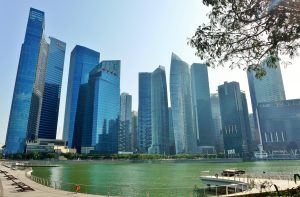Degree for change – the key to fighting climate change and protect asset values
- Review of energy consumption patterns, commitment to cut carbon emissions, and investments in technology key to fighting climate change
Singapore’s prime office real estate in the financial district is susceptible to the risks of climate change as sea levels rise, requiring landlords and occupiers alike to take urgent action to protect asset values, according to CBRE’s latest ViewPoint report titled “ºC for Change” (Degree for Change).

Degree for change report said that the real estate industry plays a pivotal role in Singapore’s fight against climate change, an effort that calls for a review of energy consumption patterns, commitment to cut carbon emissions and investments in technology to monitor performance.
Degree for change report said Singapore is vulnerable to prolonged heat waves, increased flash floods and rising sea levels as a result of climate change. While the government has adopted several pre-emptive policies to mitigate the impact, the measures do not completely eradicate the risks. Given that approximately 30% of land are already less than 5 metres above sea level, properties in Singapore remain exposed to inland flooding.
Assuming an average global temperature increase of 1.5°C, about 20.82 million square feet of office space in 51 buildings are in high flood risk areas in Singapore as of the first quarter of 2020. The core CBD is the most vulnerable, led by the Marina Bay area, which accounts for 45.2 percent of office net lettable area (NLA) exposed to rising sea levels. This is followed by Raffles Place with 31.7 percent, Shenton Way with 11.7 percent and Tanjong Pagar with 11.4 percent.
If global temperatures rise by 4°C, an additional 4.03 million square feet of office stock across 13 buildings in the CBD may be under threat, including those in the Marina Centre, Beach Road/City Hall and Orchard areas.
Mr Desmond Sim, Head of Research, Singapore and Southeast Asia, at CBRE, said, “Given that we have already crossed the 1°C warming mark, the reality of global temperatures rising by another 0.5°C is becoming increasing imminent. We must take counter-measures urgently because the material threat to property values from climate change is very real and hitting close to home.”
A collective effort to combat climate change: what this means for landlords, occupiers and investors
To slow the pace of increase in sea levels, the long-term goal is to reduce carbon emissions. Within the real estate sector – which accounts for about one-fifth of Singapore’s carbon emissions – asset owners and occupiers play a collective role alongside authorities.
Building owners are tapping on incentives to redevelop existing properties or build new developments, while occupiers are incorporating green fit-outs to enhance energy efficiency and monitor usage. These translate to energy savings of at least 25 percent based on the energy modelling framework by the Building and Construction Authority (BCA).
The commercial sector will continue to see more mixed-use developments which are typically more intensive in energy usage. This will prompt building owners to explore different sources of energy to decarbonise and to reduce consumption and operating costs, such as through the use of solar power.
In addition to a rising number of landlords greening their real estate portfolios, occupiers are incorporating green clauses in their commercial leasing requirements. As the two sides engage in dialogue, cross-share consumption data and monitor performance on waste management, energy and water efficiency, these will help reduce a building’s carbon footprint.
With more real estate companies seeking funds for sustainable real estate development or to refurbish buildings with energy-efficient features, Singapore’s green financing market is seeing an increase in green loans, green bonds and sustainability-linked loans.
Mr Sim adds, “The various incentive schemes under the BCA have encouraged the adoption of environmentally friendly building technologies and designs to boost energy efficiency. This helps to reduce greenhouse gases emitted by the industry, which is key to our efforts to slow the increase in sea levels.”
As energy audits for commercial office buildings gain greater prominence, the level of transparency in data and performance reporting will rise, driving further improvements in energy efficiency toward achieving the BCA’s Super Low Energy (SLE)1 and Zero Energy Building (ZEB)2 status. The BCA has a goal to improve energy efficiency in buildings by 60 percent to 80 percent by 2030 from 2005 levels, and Singapore is targeting net zero carbon emissions beyond 2050.
Prime Minister Lee Hsien Loong said at the Climate Action Summit 2019 that “the consequences of climate change are catastrophic and affect all countries. This include new diseases, more extreme weather events, food shortages, forced migration, and even wars. Like many Small Island States, Singapore is vulnerable, especially to the effects of global warming, and especially the rise of sea-levels. For us, climate change is existential.”
“Singapore contributes only 0.11 per cent of global emissions. Nevertheless, we have played our part as responsible global citizens to mitigate climate change. We pledged in Paris to peak our carbon emissions in around 2030. We are switching to a cleaner fuel mix, and deploying cleaner energy solutions. Being small and highly urbanised, we are disadvantaged in terms of alternative energy. But we are developing creative solutions within our constraints. For example, we are using solar energy to the maximum extent possible and installing large scale solar panels that float in our reservoirs and off our shorelines in the sea.
“We also implemented a carbon tax this year, with the intention of increasing it over the next ten years. And we are greening our physical and transport infrastructure. We are aiming for 80 per cent of buildings in Singapore to be green by 2030. And for 90 per cent of peak hour commuting trips to be via public transport, active mobility or shared transport by 2040. We are also developing our long-term low emissions development strategy, as called for under the Paris Agreement.”






